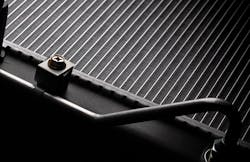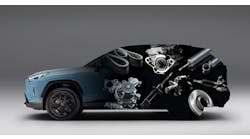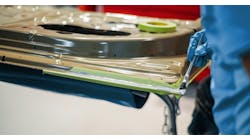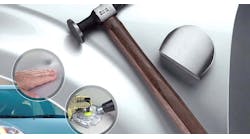Radiator performance is directly related to vehicle performance. If a radiator is damaged in a collision and not properly repaired, the engine could overheat, could cause a coolant leak, or the transmission could fail.
That's why it's critical to properly assess front-end damage to determine if the radiator or the condenser have been affected by a collision, then follow the proper procedures to repair or replace.
After a Collision—Look for Clues
All modern Toyota and Lexus models use unibody construction. Unibody structural components support the weight of the vehicle and absorb road shock as well as the energy of an impact. This includes components like the radiator support. Whenever there is damage to the radiator support, you need to inspect both the support and the condition of the radiator.
If the radiator or the condenser have been crushed by the impact, repair is never an option—replacement is required.
There may be hidden damage to the radiator, so take the time to test the components thoroughly to determine if a repair is possible, or if replacement is required.
Inspect the vehicle for all forms of damage:
- Visible damage
- Dimensional misalignment
- Improper previous repairs
Any of these can affect radiator performance, which ultimately affects vehicle performance. If you don't catch this kind of damage before returning the vehicle to the customer, you may risk damaging customer satisfaction.
Radiators Have Evolved
Just as today’s vehicles have evolved, so have radiators. Radiators used to be made of brass and copper. They did a great job of keeping an engine cool, but they were heavy and expensive to produce. Next, aluminum radiators became popular because they weigh approximately sixty percent less than brass and copper ones, while still delivering excellent engine cooling performance. Today, while many radiators still maintain an aluminum core, they now include plastic top and bottom tanks. This helps keep weight and cost down while maintaining efficiency.
It's Good to be Genuine
If you have to replace the radiator or condenser, Genuine Toyota parts are the best choice because:
- They’re guaranteed to fit right the first time, making installation easy.
- They’re engineered to meet all applicable federal regulations required when the vehicle was produced. Additionally, they meet Toyota and Lexus crashworthiness and occupant safety standards in the event of a subsequent collision.
- Genuine Toyota and Lexus radiators have outstanding durability and cooling performance:
- They have thermoplastic tanks to ensure consistent tank thickness and shape for accurate mounting and optimal performance; plus, they’re designed for long-term durability and can withstand high fluid temperatures and heat radiated from the engine.
- Header plates are engineered and precision stamped to provide secure mating to the core, which helps to ensure dependable long-lasting performance.
- Radiator tubes and fins are designed for optimum coolant flow, allowing efficient heat transfer to fins; the fin pitch and louver design create the optimum balance between air flow and heat transfer.
- Tubes are designed to be strong so they withstand the impact from road debris.
- The radiator tank gasket is made of a unique rubber material to help ensure durability due to temperature cycling.
- The thick aluminum condenser tank is engineered to sustain a highly pressurized system.
- The receiver dryer has the same size desiccant bag as the OE equivalent.
- They’re built to withstand a boiling point over 10,000 times, up to twice as much as top imitations.
- They’re backed by the Genuine Toyota Parts 12-month, unlimited mileage warranty.
You may think that quality comes at a cost. Not with Genuine Toyota and Lexus radiators. With competitive pricing and outstanding engineering, you and your customers benefit from Genuine Toyota and Lexus quality, fit, form, and function at a price that’s competitive with the aftermarket. To learn more, visit toyotapartsandservice.com.




